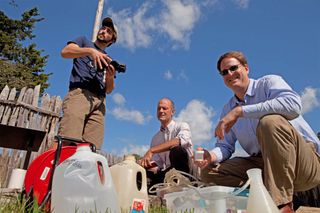Pocahontas Drank Here (But You Wouldn't Want To)

This Research in Action article was provided to LiveScience in partnership with the National Science Foundation.
It's the Year of Our Lord 1609. John Smith has left the Virginia Colony's two-year-old settlement at Jamestown to return to England. The natives have only enough food to feed their own population and won't trade with the colonists, who begin taking food forcibly. Smith's fragile truce with the Indians rapidly falls apart. The First Anglo-Powhatan War has started.
We now know that the Jamestown colonists' fear of Indian attacks kept them pinned inside their palisade during that winter, a period that became known as "the starving time." Only 10 percent of the colonists survived that winter.
James Whittenburg, a historian at the College of William & Mary's National Institute of American History & Democracy (NIAHD), said that starving-time colonists ate their own domestic animals. When the horses and dogs ran out, they turned to rats and snakes. When they got thirsty, they had wells inside the fort, but the water was just plain awful.
Thirsty times
The role of drinking water in the decimation of the colony has been a matter of speculation. A team of William & Mary geologists has been sampling water from the same wells used by the Jamestown colonists — and they've found it foul indeed.
Doug Rowland, a geology student at William & Mary, is working with geology professors Greg Hancock and Jim Kaste to sample and analyze water from the 400-year-old wells. The three wells inside the fort filled-in years ago, but workers installed piping at all three well sites to allow access to the same shallow aquifer used by John Smith and the Virginia Company.
Sign up for the Live Science daily newsletter now
Get the world’s most fascinating discoveries delivered straight to your inbox.
Jamestown fort is on a slight rise of land between the brackish James River and the even more saline Pitch and Tar Swamp. The salty water infiltrates the wells, though the degree of infiltration depends on the tide and other factors.
Toxic waters
The scientists are also finding high, but varying, levels of arsenic in the water. A popular legend said that the Spanish spiked the Jamestown wells with arsenic, but Kaste said arsenic is a natural component of the aquifer.
Arsenic wouldn't have been the biggest problem for the Virginia Company, anyway. It is just one ingredient in an unhealthy cocktail that includes high levels of salts, various other metals and fecal contamination. Today's fecal-coliform contribution comes from Jamestown Island's numerous colonies of Canada geese; back in the day, percolation from the Colonists' outhouses would likely have made the fecal coliform count even higher. The water even smells of sulfur, a probable contribution of sulfur-reducing bacteria.
At a recent sampling, a group of archaeologists working at Jamestown buttonholed Hancock. They wanted a few gallons of the water to make a batch of authentic Jamestown beer. The geologists discussed what authentic Jamestown beer might taste like as their battery-powered pump brought up a stream of reeking water that caused wrinkled noses on tourists several feet away.
"You know," Kaste deadpanned, looking across the compound at where their fellow scientists, the archaeologists, were working, "we really ought to give them some water."
Any opinions, findings, and conclusions or recommendations expressed in this material are those of the author and do not necessarily reflect the views of the National Science Foundation. See the Research in Action archive.
Most Popular




